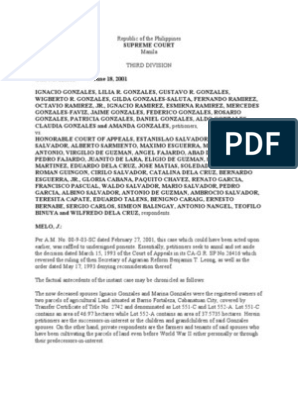0% found this document useful (0 votes)
301 views2 pagesAbangan v. Abangan
This document summarizes a court case from the Philippines regarding the probate of Ana Abangan's will. The will consisted of two sheets - the first sheet contained the testamentary dispositions signed by the testatrix and witnesses, and the second sheet contained only the attestation clause signed by the witnesses. Opponents to the will argued it should not be admitted to probate because the sheets were not signed on the left margin or numbered by letters as required by law. However, the court determined these additional requirements were not necessary since the dispositive parts of the will were wholly written on one sheet signed at the bottom, and removing an unnumbered single sheet would not hide any changes. Therefore, the will was duly admitted
Uploaded by
Kazper BermejoCopyright
© © All Rights Reserved
We take content rights seriously. If you suspect this is your content, claim it here.
Available Formats
Download as DOCX, PDF, TXT or read online on Scribd
0% found this document useful (0 votes)
301 views2 pagesAbangan v. Abangan
This document summarizes a court case from the Philippines regarding the probate of Ana Abangan's will. The will consisted of two sheets - the first sheet contained the testamentary dispositions signed by the testatrix and witnesses, and the second sheet contained only the attestation clause signed by the witnesses. Opponents to the will argued it should not be admitted to probate because the sheets were not signed on the left margin or numbered by letters as required by law. However, the court determined these additional requirements were not necessary since the dispositive parts of the will were wholly written on one sheet signed at the bottom, and removing an unnumbered single sheet would not hide any changes. Therefore, the will was duly admitted
Uploaded by
Kazper BermejoCopyright
© © All Rights Reserved
We take content rights seriously. If you suspect this is your content, claim it here.
Available Formats
Download as DOCX, PDF, TXT or read online on Scribd
/ 2














































































































